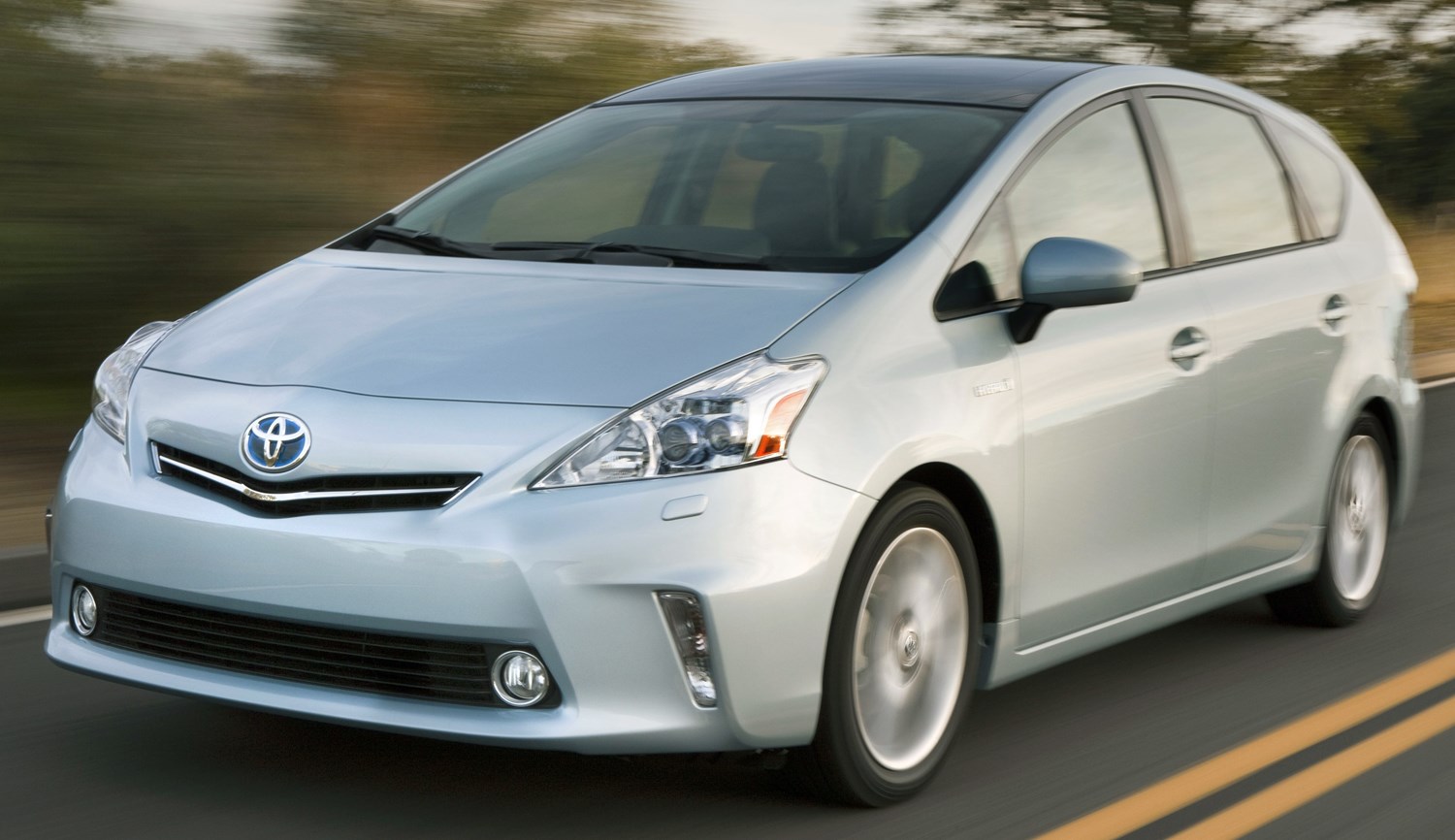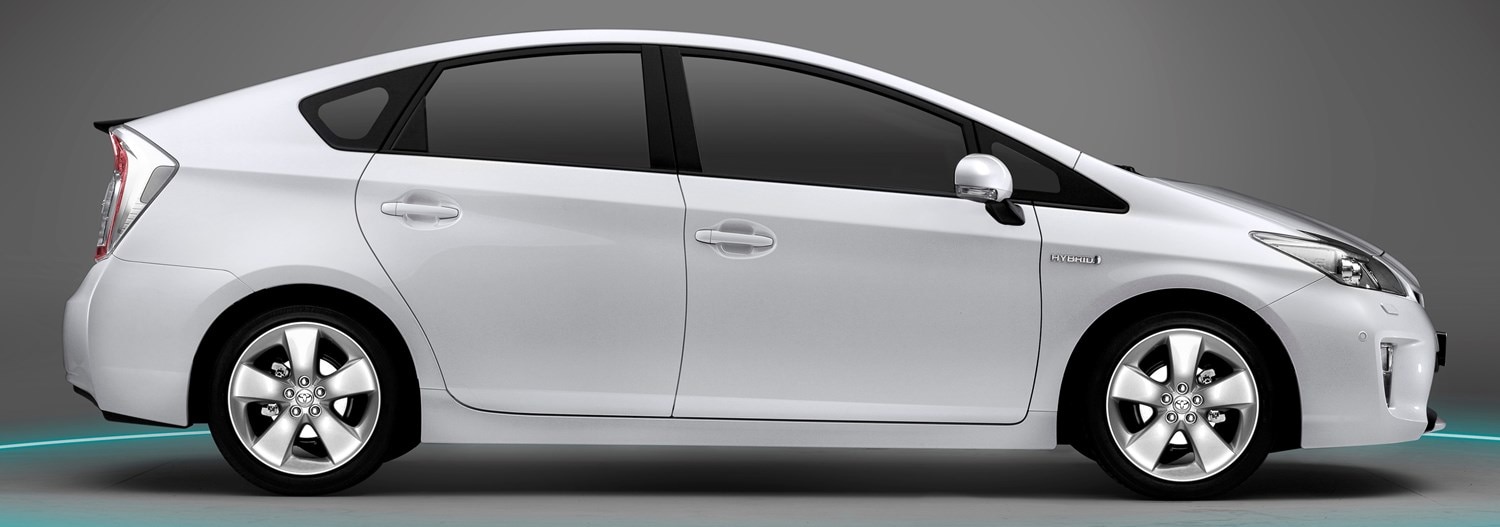Model review
Toyota first introduced the Prius – from the Latin for 'prior to', in order to reflect that the car is ahead of its time – at the Tokyo Motor Show in 1995. Recognised as the first volume-produced hybrid car, the Prius first went on sale in 1997 and has always been offered as a five-door, five-seat family car with a petrol-electric powertrain.
They were first introduced to the UK market in 2000, coming shortly after the Honda Insight as the first hybrid on sale here.
Alongside the 'Hybrid Synergy Drive' (Toyota's name for its hybrid technology), the Prius was engineered specifically to exploit every possible area of physics for enhanced fuel economy. The body was designed to be as slippery as technology would allow and the Prius had one of the lowest drag coefficients of any production car at the time – other manufacturers are only catching up to it now.
Low rolling resistance tyres meant that the car had less drag caused by its own weight too, and enabled it to coast for long distances, topping the battery up as it went.
The first generation car was replaced in 2003 with a new model which continued with the same approach. A new liftback body style that persists to this day allowed for an even lower drag coefficient, while the hybrid battery technology had advanced further to make the Prius a better long-distance prospect.
This car won European Car of the Year in 2005, in a rare victory for a car using electric power. After more than a million sales, it was replaced with a third generation car in 2009 that saw further refinements.
The third generation introduced both the seven-seat Prius+ model, which is still on sale today alongside the newer fourth generation five-seater, and a Plug-In hybrid version to allow for extended battery-only range and topping up through recharging points rather than regenerative braking alone.

Latest model
The current Prius reached the UK market in 2016, following a 2015 debut in Japan. Although the front end remains broadly similar to the previous car, it has been significantly redesigned around the sides and the rear to make it even more aerodynamic than before – the fourth generation Prius has a drag coefficient of 0.24, 20% better than an average hatchback.
Introduced alongside the Prius was a PHEV variant simply called the Prius Plug-In. It has notably different styling and an extra 8.8kW battery storage pack, but both cars share the same hybrid technology and sit on the same Toyota New Global Architecture (TNGA) platform that's also used for the CH-R crossover.
All Prius models are powered by the same petrol-electric setup. This pairs a 1.8-litre, four-cylinder petrol engine with a 53kW electric motor, to produce around 120hp when both units are in operation.
The motor also works as a generator, harvesting what would be otherwise wasted energy from coasting and deceleration to turn back into power when needed, while the plug-in car also has a battery pack you can charge at home or at public charging points to provide longer distance and higher speed motor operation without needing the petrol engine.
Both versions have high official fuel economy ratings, at 94.1mpg and 282mpg respectively and while it may be difficult to match these figures in the real world, depending on your driving style, you can expect some impressive numbers nonetheless. Performance isn't terrific, but even the slower Plug-In car manages 0-60mph in 10.9s, which betters many small, diesel superminis.
Trim lines are the normal Toyota fare, with Active as the entry level and Excel as the top grade. There's a fleet-friendly Business trim between the two, and a Business Plus version that adds a few toys like sat nav and larger alloy wheels.
Value for money
On the face of it, the Prius is rather pricey. It's a five-door, five-seat family car with a 1.8-litre engine that will set you back an absolute minimum of £24,115. Equipment levels are decent, but not all that striking – automatic LED headlights, adaptive cruise control and a reversing camera are all standard, but navigation and heated or leather seats aren't.
Primarily what you're paying for is the huge amount of standard safety kit and that hybrid system. The Prius is officially rated at 94.1mpg and 70g/km CO2. Although it's not likely you'll match that fuel economy figure in the real world, it's still good for around 70mpg – more if you're really good at maximising the regenerative braking – and as it uses petrol rather than diesel it'll save you money on the very rare visits you make to petrol stations.
Watch out for the larger alloy wheels on the higher grade cars, as they can take about 10% out of your fuel economy. Toyota offers the smaller wheels as an option on these cars.
There's also a Plug-In version of the hybrid available, with an 8.8kW battery. This allows for a range of 39 miles, at up to 83mph, on battery power alone, and although the official 282mpg is also unlikely, it's still going to keep you away from the pumps. It's even more expensive though, starting at £29,195, and even though it's eligible for a £2,500 plug-in car grant, it's a bit steep.
Insurance costs and depreciation are reasonable though. In the early days of the Prius these could be a wrinkle, but as more cars use battery power and the technology has proven reliable, second-hand values have stabilised and insurers are no longer as wary. All versions of the Prius site between group 14 and group 22, well in the bottom-half of the categories.
Looks and image
The Prius is all about fuel economy and low emissions and, like it or not, that comes with a very singular image. It's the poster-child for the environmentally conscious, and the polar opposite of the petrolhead. This innately comes with a stigma, that people who buy the Prius aren't interested in cars or driving and are instead green activist bores.
Although earlier Prius models were a little dreary to look at, the fourth generation is anything but. In fact the regular car borders on the challenging, albeit fairly striking at night. The Plug-In version is a different and more coherent design that just about strikes the right balance between car and spaceship.
Toyota has a bit of a grey-hair image about it too. Despite a number of interesting sports cars over the years – Supra, MR2, Celica – the company only makes one car, the GT86, to excite and entice younger buyers. The rest of the range comes across as slightly dull, if reliable.

Space and practicality
Ultimately, the Prius is a regular, five-door family car, and this means it's a very family friendly vehicle.
There's plenty of room in the front and, even though the batteries are under the rear seats, space in the back is decent too, but headroom could be better. Luggage capacity is a bit of a mixed bag, though it's improved over the previous car. There's 343 litres available in the boot, although if you opt for the space saver tyre instead of the repair kit, this falls to 297 litres.
The Plug-In version is more limited, at 191 litres. With the rear seats down and packed to the roof, the Prius can hold 1,558 litres, although again the spare wheel shrinks this a bit to 1,512 litres and the PHEV can only hold 1,204 litres.
EuroNCAP has tested nearly every generation of the Prius, and scored it with the maximum five stars on every occasion. This was no different when the newest car was tested in 2016, with 92% in adult occupant safety and 85% in the safety assist category.
Engines
Whichever Prius you choose, it only has one engine option, although it uses two different power sources, with a petrol engine and an electric motor combining to make the 'Hybrid Synergy Drive'.
The petrol unit is a 1.8-litre, four-cylinder 'Atkinson Cycle', producing 97hp. The Atkinson Cycle is a way of extracting more efficiency with clever valve timing, but it comes at the expense of power which is why the specific power output of 53hp/litre seems a little low.
It's paired to a 53kW electric motor which produces the equivalent of 71hp. As the power curves of the two engines are slightly different, and indeed may be used separately as required, they combine to give a peak power output of 120hp.
Driving a variable speed automatic gearbox, it's enough to give the Prius a 0-60mph time of 10.4s and a top speed of 112mph, while the Plug-In is slightly slower at 10.9s and 110mph.
On paper, the Prius can achieve a combined fuel economy of 94.1mpg, although this falls to 85.6mpg if you opt for the 17-inch wheels. With the increased power storage of the Plug-In, fuel economy is rated at 282mpg, although you're not likely to see that in the real world. CO2 emissions are 70g/km, or 76g/km with the larger wheels, while the Plug-In is rated to 22g/km.
Running costs
You wouldn't expect a hybrid to be particularly costly to run, and even though the official fuel economy figures are a little optimistic – as they are for most cars – the Prius is going to be one of the cheapest cars you can buy when it comes to cost at the pumps. You should exercise some caution on fitting the larger, 17-inch wheels, as they'll reduce the fuel economy by around 10%.
The large wheels also affect the year one VED rate, as they push the Prius's CO2 rating up one bracket. The difference is just £75 – the regular car is £25 in the first year, and the 17-inch option is £100 – and there's no change to the yearly tariff of £140 thereafter. The PHEV variant is £10 for the first year and £140 for subsequent years.
Insurance could be an unusual expense on older Prius models as insurers were unsure about battery technology safety and costs of repair/replacement. These days it's not a problem, with the Prius sitting in group 14 (of 50) and the Plug-In only slightly higher in group 21-22.
Service and repair bills aren't the issue you might think they are either. The Prius should cost almost the same as Toyota's more conventional family cars, although bear in mind that the complex electrical systems – particularly for the Plug-In – may leave you beholden to dealers for servicing.

Things to look out for
Across all four generation, the Prius has been a relatively healthy car and regularly finds itself in the top 20% of reliability surveys. Initial concerns about the longevity of the batteries seem to have been unfounded, with no obvious issues recorded.
That said, the car has been subject to a number of recalls, for issues ranging from airbags and parking brakes through to hybrid system failures – they are complex systems and manufacturing defects occasionally creep in and cause the hybrid drive to shut down to protect itself. It's vital to check that your car has had the required repairs to remedy these faults.
Aside from recalls, there does not seem to be any notable pattern of issues with the Prius. You'll find a lot of Prius minicabs around the world now too, testament to its reliability. Be aware though that Toyota has shortened the warranty on the hybrid system, to 5 years/100,000 miles for the latest car.
Rivals
Strangely, Toyota offers a number of in-house rivals to the Prius as it expands the hybrid technology across its range. These include the Auris – which also has a practical estate version – and smaller Yaris, while the C-HR and RAV4 crossovers also have hybrid options. The Lexus CT could be considered an upmarket version too.
A key rival from elsewhere would be the Volkswagen Golf GTE, which manages to cram all the hybrid gubbins into a car that looks no different from a regular Golf. It also offers the larger Passat in a similar GTE trim, and the more conventional looks of the two Volkswagens may appeal. Kia and Hyundai also produce similar hybrids, the Niro and Ioniq respectively, and the Ioniq is also available as a regular hybrid and a PHEV, just like the Prius.
Depreciation warning
The Prius largely holds onto its value rather well by comparison to many of its stablemates. The fuel economy from a petrol engine seems to hold some appeal to second and third owners, and the highly recognisable Prius name appears to help to buoy prices.
There doesn't seem to be much of a difference between the various trim levels when it comes to used prices, though there isn't really so much of a difference between them when it comes to equipment either – the fleet-friendly Business Edition models offer the best new value, but the miles they tend to rack up in fleet use put a mild dent in the used value.
Generally, whichever Prius you select you can expect around 50% back after 3 years on average mileage. It's early days for the Plug-In model, but we'd expect a poorer return simply due to the much higher initial purchase price.





